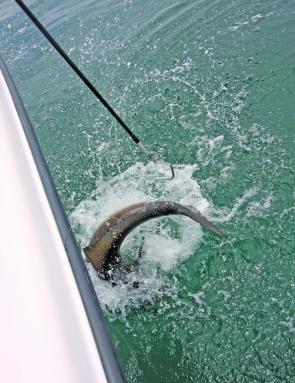In part 2 of Kim’s Cobia piece we delve into some likely locations and finish off getting the fish into the boat.
Cobia are often taken from the shipping channel beacons in the central and northern bay (at least those beacons from the old ‘four-beacons’ area all the way up to Caloundra). I use the same outfit as for Western Rocks but often with a heavier lead sinker in order to account for the greater water depth and the faster water flow. Big live baits are the go, particularly yakkas that are jigged from alongside the beacons on bait jigs and also slimy mackerel if you can get them. Normally I try to get the rigged livies (or my bucktail jigs) down to the bottom unless my sounder shows suspended fish. If the fish are suspended then I expressly target that zone.
Keep in mind, that with gentle pressure on these cobia, you can lead them away from the beacon. Then you can push the drag up and get down and angry tough in a head to head brawl with these bulldozers as they try to make it back to the beacon you coerced them away from (or one of the other beacons that they are making a beeline for).
I deploy the livie over the side as the boat drifts up to and past the vertical poles. When the current slows, such as an hour before the turn of the tide (either high or low water), I’ll run a berley trail if the fishing is slow. Generally I fish these spots from an hour before the tide turns to about an hour after the tide picks up. Late afternoon has often been the best time of day.
A reasonable plan is to fish Western Rocks during the day and hit a few beacons on the way home (if the tide is right).
Always berley for cobia – I have distant memories as a young child of working the berley pot (about 120kgs of prawn heads) and seeing a pack of cobes rise up under me out of the depths. I did get a bit of a fright as I first thought they were sharks. Cobia do look a bit like sharks in the water – to get a quick ID on them look at their tails and also look for the white lateral stripe on their body – oh yes the little juvenile cobia sometimes also look like remora; and remora have a white lateral stripe too.
Cobia will sometimes follow a hooked fish to the boat. This provides anglers with a great opportunity for a double hook-up. When targeting cobia in this situation, we always get an angler ready at the bow of the boat with a livie rigged ready to go on a spin stick. The drill is for them to stand there, out of the way and with their livie in the water and ready to cast it out. Generally there is no need to cast it on top of the hooked fish and risk a tangle; rather lobbing it in the broader area will generally get the spare fish interested enough to wander over for a look. In this case we generally let the livie run around in freespool – only closing the bail arm once that cavernous cobia mouth has taken the live bait down whole.
I like to keep the boat going ahead and I lead the fish along the side of the boat so that the cobia remains horizontal in the water. If you stop the boat a tired cobia will often hang vertical in the water and in this position they are very hard to gaff. Also if the gaff does slip off the fish, then the gaff will often make contact with the leader because the gaff is being pulled up towards the boat. This can cause a tangle or cut and subsequently cost you a fish. The best plan is to keep the fish in the water and horizontal and have your gaffer gaff from behind you (behind the direction of the fish’s forward movement) and therefore away from your line.
Keep in mind that they can be very powerful (and destructive) once in the boat compared to for example a mackerel which is usually plum tuckered out by the time the gaff goes in.
Just a Tip ; watch out for those nasty dorsal spines on the cobia that “pop” up – very sharp and dangerous when you are trying to hold a wriggling slippery cobia for a photo.
Cobia are very good eating. To prepare them for the table – firstly fillet them, roll the fillet off and cut angled slices down the flesh and twist the knife at the end to get a thinner fillet without any skin on it. These angled cuts give easily and quickly cooked fillets of one of the best tasting fishes in the sea.
Reads: 2354






